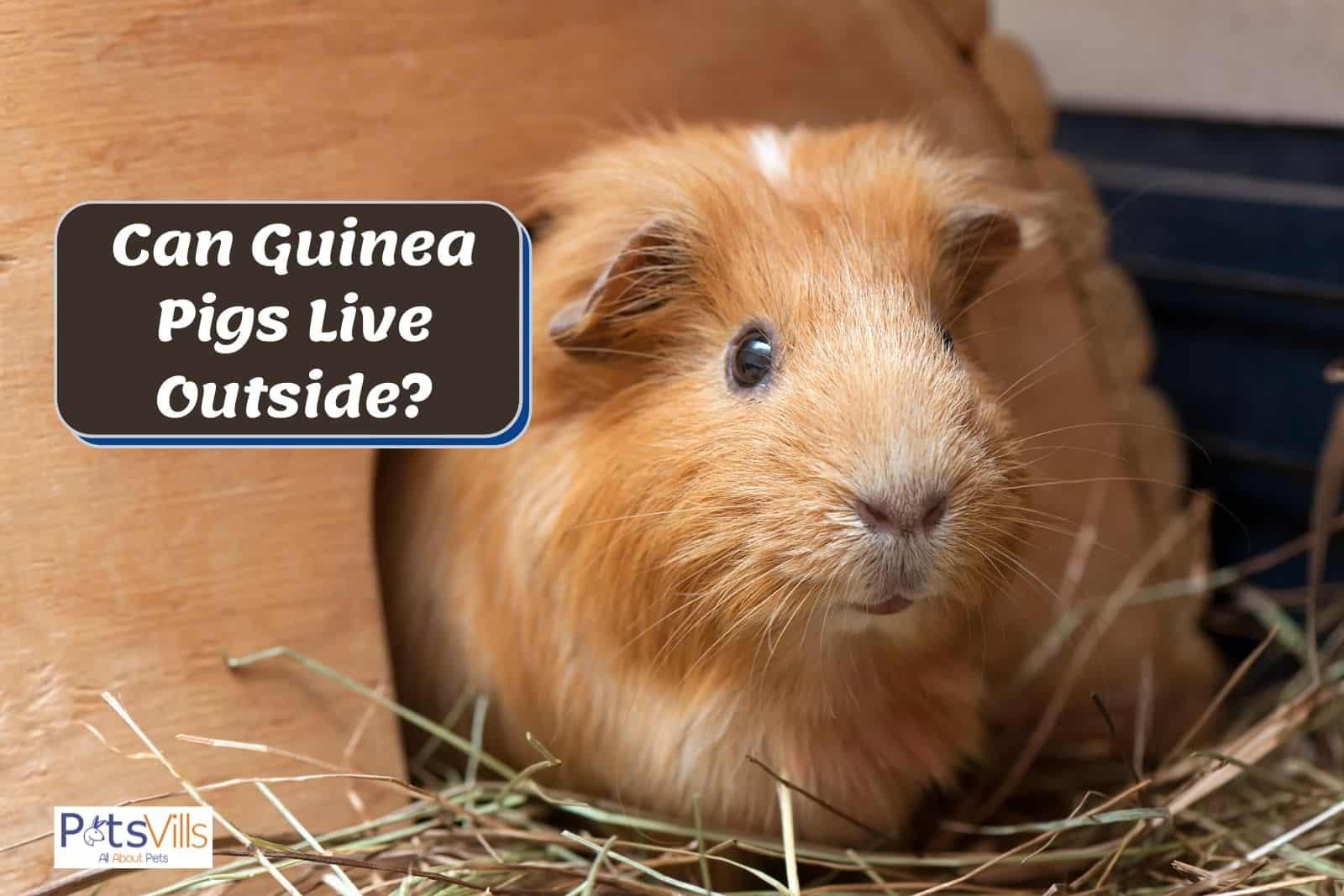When you first get a guinea pig you might be wondering whether they can live outside all year round?
Can guinea pigs live outside?
Guinea pigs can live outside all year round, but you need to prepare their hutch for winter to make sure they are kept warm.
Guinea pigs can tolerate cold temperatures quite pretty well.
In this article, we will be discussing how you can prepare your guinea pig for winter and extra security to keep your guinea pig safe from other animals such as foxes and cats!
READ MORE: How to Know if Your Guinea Pig Likes You
Table of Contents
Can Guinea Pigs Live Outside?
Just like rabbits, guinea pigs can live outside all year round. In the winter you will need to prepare their hutch for colder temperatures. (Scroll down on how to do this).
It’s important to note that you should well protect your guinea pig’s cage from other animals such as foxes, badgers, and cats. These animals have been known to hunt and kill guinea pigs.
You can add additional security by using a padlock and placing a rug or a cover over the cage. This will also help your guinea pigs with stress as they won’t be able to see out of their cage.
Adding something heavy to the top of the hutch will also prevent it from being opened at the top.
Can My Guinea Pig Stay Outside During Winter?
It all depends on external conditions. The most influential factor to keeping your guinea pigs outside will be the climate of your area.
If you live closer to the equator where the weather is always warm, then yes, you could probably keep your guinea pig outside even in the winter months.
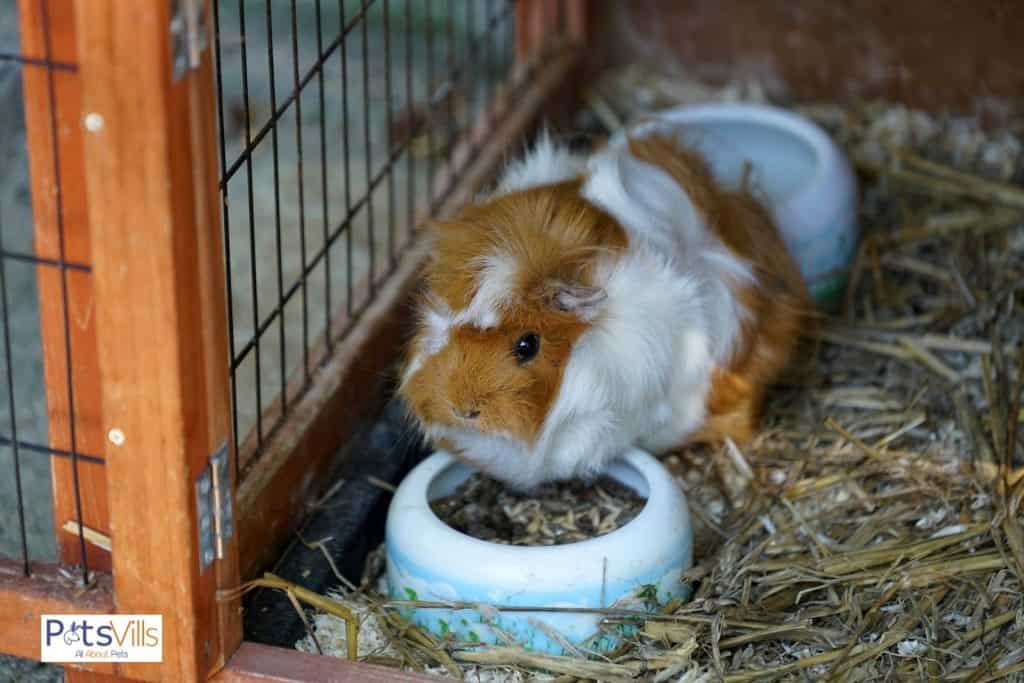
Even in warmer climates, you will need to monitor the weather each day to look for upcoming cold fronts. If you see a cold front, then you need to make preparations for your guinea pig.
If you live in a climate that goes through a typical winter cycle then you will want to bring your guinea pigs inside. The ideal temperature for this mammal is 65 to 75 degrees Fahrenheit.
When you start to tilt below the 65 degrees point, your guinea pig may begin to become less active or even show signs of hypothermia the lower the temperatures dip.
It may be possible to keep your guinea pig outside with proper improvements to their environment on warmer days in winter.
Preparing an Outside Hutch for Winter
If you want to keep your guinea pig outside on the warmer days of winter, then there are some ways to achieve this while still keeping them safe.
To start off, try insulating the hutch the keep more heat in and block out the winter air. You can do this by using carpet or thick blankets to cover the cage.
You will need to cover both the inside and outside walls to insulate the hutch properly. Make sure the inside walls are guinea pig-safe material in case of chewing.
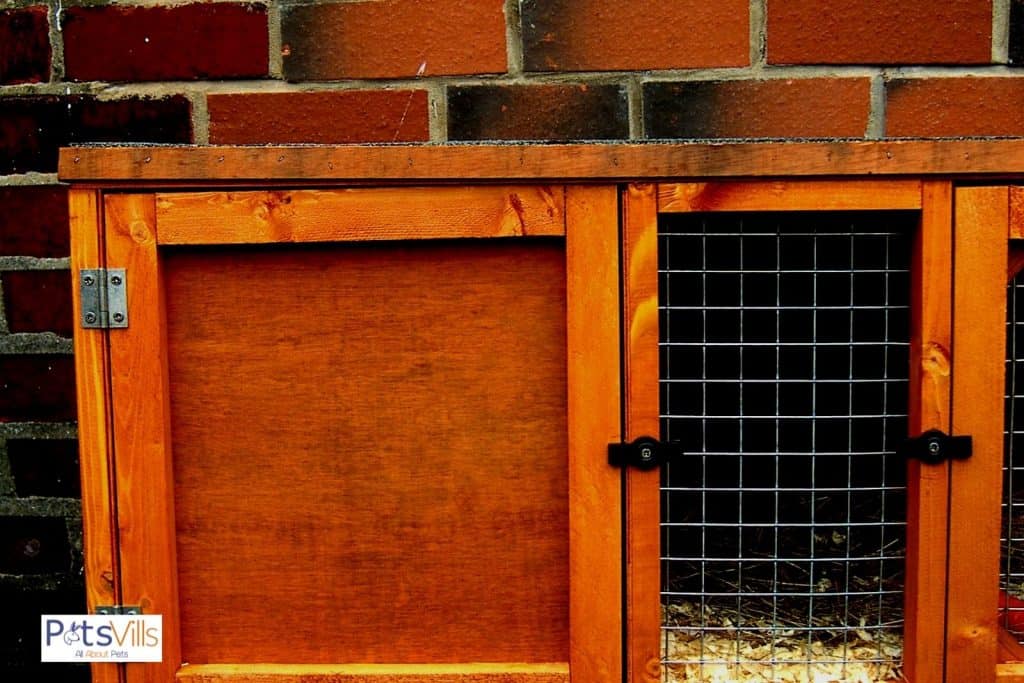
Try to place the cage high up off the ground where it will be less susceptible to the elements. Make sure the spot you choose will be able to block as much wind as possible.
Next, you will want to build a solid slanted roof over your hutch. This will keep cold rain out and keep your guinea pigs dry during lousy weather.
Fill the cage with hay so that your guinea pig will have a warm place to sleep. You can pile the hay more on one side of the hutch than the other to give them a burrowing option.
Other Possibilities
If possible, consider using a ceramic heating bulb or heating pads to help with the cold. You will need to run an extension cord to the hutch; this can be challenging depending on location.
Even the most well-insulated cage will need to be checked each day. Water bottles that aren’t covered often freeze overnight cutting off the water supply.
If you think your guinea pig is starting to act funny them bring them inside. Changes in habits are one of the number one indicators of possible hypothermia.
Take a look at this video:
Keeping Your Guinea Pig Warm in Winter
Keeping your guinea pig warm in winter doesn’t have to be a hassle. As mentioned above, you should bring your guinea pigs in for winter when the temperature drops below 60-degrees Fahrenheit.
During the winter, make sure to keep your temperature turned up at all times. If you run hot, then you can move your guinea pig’s cage to a smaller room and set up a portable heater.
Portable heaters can provide the warmth you’re looking for without running up your energy bill. For extra warmth, consider putting a fleece in your pet’s cage for them to sleep on.
Many specialty shops for guinea pigs sell cloth hammocks and tunnels for them to hide in. This can provide an extra layer of warmth on colder winter nights.
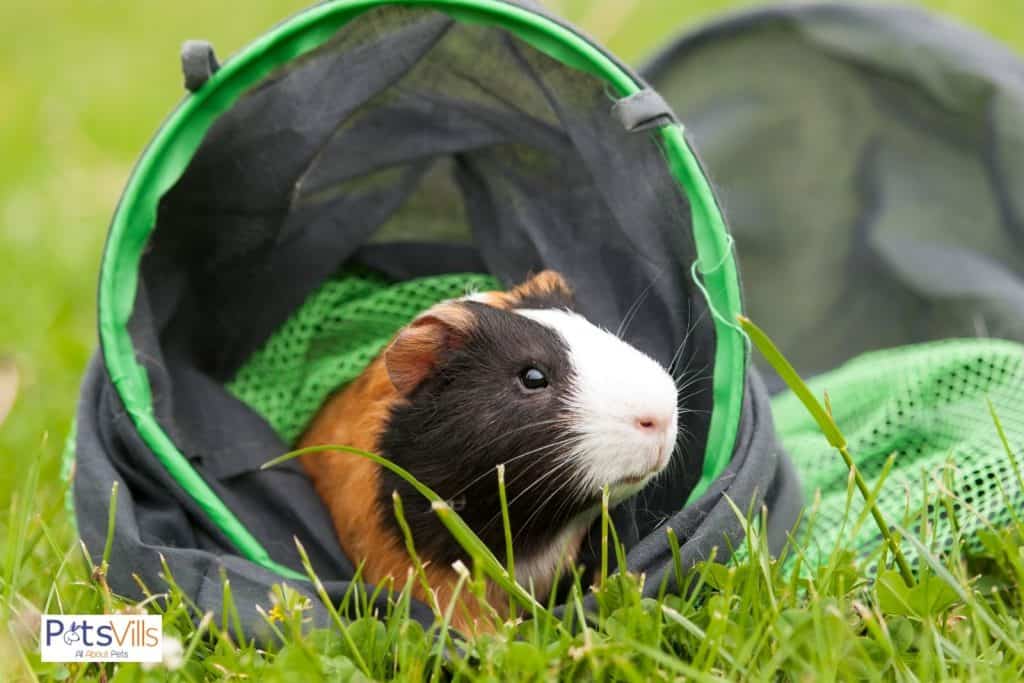
Some pet owners have turned towards using heating lamps to warm their cages. These lamps can easily be found in the reptile sections of pet stores.
For night temperatures consider using a ceramic heater. Ceramic heaters help to heat the cage without putting off any light. This can help keep your cage dark when night comes.
If your cage sits near a window, then move it to another location. Cold drafts can quickly come in and cause your guinea pig to become cold.
READ MORE: Do Guinea Pigs Like to Live Alone or in Pairs?
When Your Guinea Pig Can Go Back Outside
A guinea pig should be able to survive outside again, starting in mid-spring. You will want to closely watch the temperature as there are still points in late spring the temperature will dip.
Until summer hits keep a backup area in your home for your guinea pigs. It will also be best to skip the rainy months if when possible.
Months with more rain see temperatures that tend to fluctuate more often.
Guinea pigs that have to fight against changing temperatures are prone to more health problems. Just like with people, a constant is needed to keep the body performing correctly.
Make sure you have made the proper adjustments to your guinea pig’s hutch. A hutch that was modified for winter will be too hot in warmer months.
Signs Of Hypothermia
Hypothermia is a condition that can easily afflict guinea pigs not kept in the needed temperature range. Luckily, there are a few signs to watch for that can warn you of the condition.
A guinea pig could stop taking in food and water if they start to develop hypothermia. If you’ve noticed your guinea pig hasn’t been touching their food, this may be your first sign of a problem.
If your guinea pig is having shortness of breath, then they may be going it hypothermia. Problems breathing or quick short breaths are sure signs of a health compilation.
The most significant sign that something has gone wrong is a lethargic animal. If a guinea pig stops moving around as much or is just laying down, in this case, a vet should be contacted.
If you find your guinea pig suffering from cold-related issues, there are steps to help. You will immediately need to begin warming your guinea pig up in a safe area.
Correcting Hypothermia
You need to gradually introduce your pet to the heat as a sudden onset can cause them to become even sicker. Use blankets or a heating pad to warm them up slowly.
After your guinea pig has warmed up and has shown more signs of energy, you will need to keep an eye on them.
Watch the activity of your pet closely for at least 24 to 48 hours after a close call.
Preventing Hypothermia
The only way to prevent your pet from going into hypothermia is proper care. Be vigilant of your pet’s environment as the weather starts to cool down.
Make sure to check the weather every day when you wake to see if your guinea pigs need to come inside. Never risk leaving your guinea pig out in the snow.
Most modern weather radars can pick up on possible incoming cold fronts. Use these radars to plan out your guinea pigs’ week, should they be moved inside or stay outside?
Always have a small cage set up inside in case of emergencies. This can help you quickly move your pets without giving them time to be exposed to the cold.
Pet-safe Heating Pads
One of the most effective ways to keep pets warm during colder months is by using pet-safe heating pads. There are tons of different pads on the market to fit the needs of your pet.
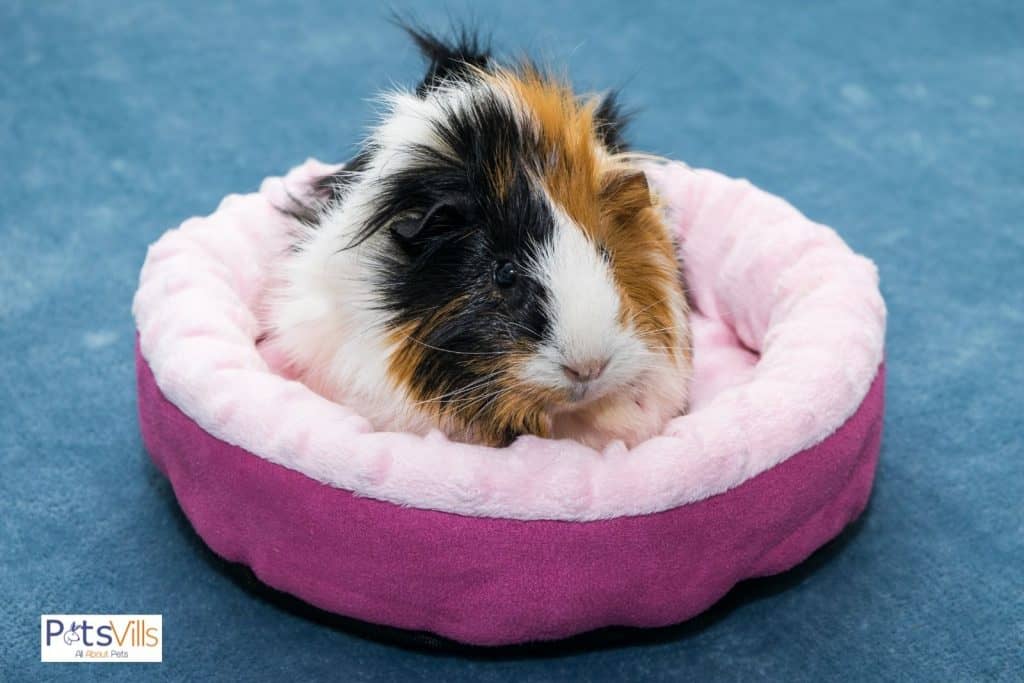
Some pads will warm to your guinea pig’s body temperature. These pads don’t need electricity, making them easier to place inside of your cage.
With non-electric pads, there’s no risk of wires being chewed on or things getting too hot. These are the perfect quick fix on days where the temperature is just a little bit cool.
Non-electric pads are safe to use when you’re asleep or not at home. You don’t have to worry about forgetting to turn the pad off when you leave.
Electric Heating Pads
Electric heating pads are available for situations where more heat is needed. These heating pads tend to go under your cage or a blanket.
You can set the temperature on the pads to a perfect 68 degrees on many electric pads.
It’s best to pick a heating pad that comes with a timer. These can help break up the amount of time the pad is running. This is especially useful when you can’t monitor your guinea pig.
Some of the best-heated pads out there can be found in reptile supplies. These pads are safe and often come with features that will work correctly for a small animal’s cage.
Reptile heaters come in a variety of sizes to fit all life stages of guide pigs. Just make sure to test the pad out when you get home before using it out of sight.
Be sure to remove the heating pad from your guinea pigs’ cage if they begin to chew the fabric. If chewing is already a problem, consider a chew-proof heating pad.
Satisfy your curiosity with our entertaining article, “50 Fun Facts About Guinea Pigs,” and get essential advice from our guide, “Can Guinea Pigs Live in a Hamster Cage,” to ensure your pet’s well-being.
Power Outage Safety
One of the worst things that can happen in the winter is an outage. Not only are outages dangerous to guinea pigs, but they can also last for days at a time.
Things become even worse if you’re snowed in with no way out. Snow will block you from being able to get to a hotel or buying supplies you may need.
In winter, prepare to have a plan in case you lose power during a winter storm. If you find yourself during a prolonged outage, consider staying with a family or in a hotel.
Moving your pet to a family or friend’s house can alleviate many problems. Some hotels will even accept caged pets, especially in outage situations.
Keeping Warm At Home
If you can’t get out of your house, then prepare a room for you and your pet to stay. Pick a small room in your house and close all the doors to keep the remaining heat from escaping.
For added heat, you can place blankets on your guinea pig’s cage. If possible, take your pet out and wrap it in a blanket. Hold them close to warm them up then place them back in their home.
This is one of the best reasons to keep a non-electric heating pad on hand. These Pads can be a lifesaver when you go days without power in the middle of winter.
Monitoring Your Cage Temperature
Monitoring the temperature of your guinea pig’s cage is an essential part of keeping them healthy. Monitoring the weather can be done through a mobile app on your phone.
For the inside of your cage though you can use a portable thermometer. Thermometers are especially handy in winter or early spring/ late fall where the temperature fluctuates.
Buying a stick on a thermometer to place in your cage can be a reliable way to monitor the health of your pet. The thermostat will let you know if temperatures start to drop.
Most thermometers cost very little, making them an easy buy. You can also buy a standard thermometer and place it outside of your pet’s page if that seems like a better option.
FAQs
How to tell if my guinea pig is cold?
If your guinea pig seems to be trying to burrow or isn’t moving as much, then you need to check the temperature.
How serious is early-stage hypothermia?
Even in the early stages, hypothermia can damage your pet’s body. If you think your pet is experiencing any level of hypothermia, get them to a vet.
Can a pair of guinea pigs keep each other warm?
Snuggling does help, but it won’t save your pet from dropping temperatures.
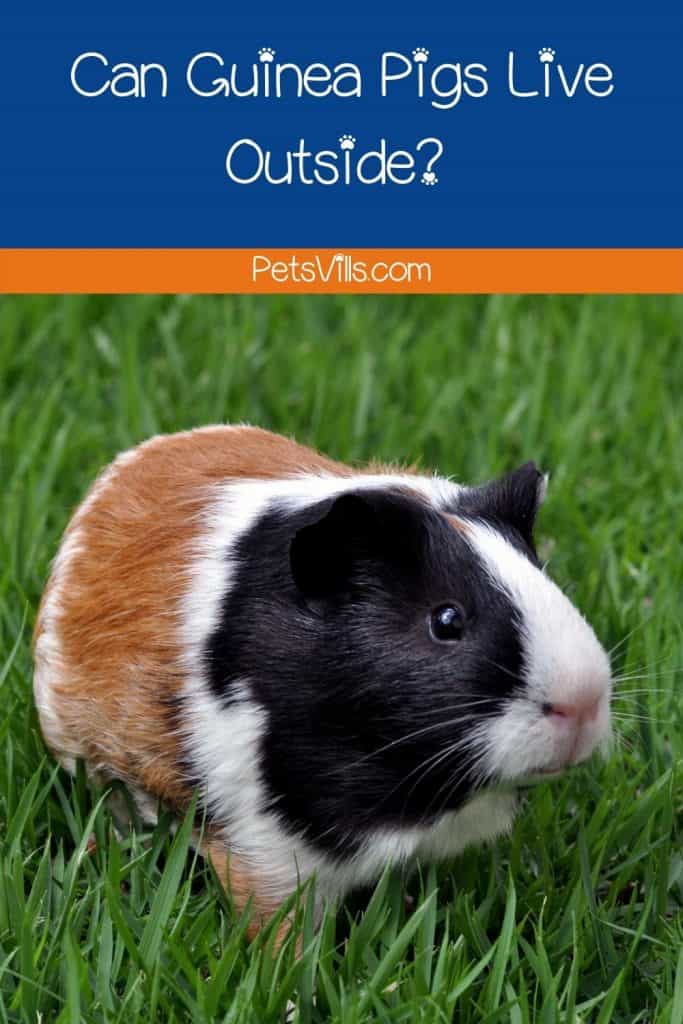
Did you put your guinea pig to live outside? Let us know how easily they spend the time outside.
Alina Hartley is a small-town girl with a ginormous love of bearded dragons. It all started with Winchester, a baby bearded who was abandoned at the shelter by his former owners because of a birth defect that caused one front leg to be shorter than the other. Alina originally went to the shelter looking for a guinea pig, but one look at Winchester and it was love at first sight. From that day on, Alina has dedicated her life to learning everything she can about bearded dragons. She loves helping new beardie parents start their incredible journey with these magnificent reptiles.
Follow her on:
LINKEDIN
TWITTER.
Read her latest articles HERE
Learn more about her HERE.

